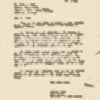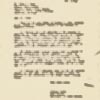Class Versus Gender: Catt Taps Middle-Class and Nativist Fears to Boost Women's Causes
Annotation
The struggle for women's suffrage began in earnest during the first half of the nineteenth century. In the post-Civil War years, women saw African Americans receive the right to vote, and large numbers of newly immigrated men participating in the electoral process. By the late nineteenth and early twentieth centuries, some white women suffrage leaders, based on a sense of both class and racial superiority, were willing to argue that members of the working classes, new immigrants, and African Americans were unprepared to take on the rights and responsibilities of suffrage. These claims served to bolster the case for granting white women the vote. Carrie Chapman Catt was active in the Iowa Woman's Suffrage Association and later the National Woman's Suffrage Association, succeeding Susan B. Anthony as president in 1890. In 1894 (a year of extraordinary class conflict which saw nearly a million workers involved in violent strikes, many of them immigrants), she addressed an Iowa suffrage gathering and maintained that women's suffrage was necessary to counter "the ignorant foreign vote" in American cities and protect the life and property of native-born Americans. This struggle over who should have the right to vote coincided with efforts to reform the electoral process.
"This Government is menaced with great danger, and that danger cannot be averted by the triumph" of the party of protection, nor by that of free trade, nor by the triumph of single tax or of free silver. That danger lies in the votes possessed by the males in the slums of the cities, and the ignorant foreign vote which was sought to be bought up by each party, to make political success. It made no difference whether that vote was usually found with one party or not (except that one has more respect for an open bid than for a disguised one), the corrupting influence was just the same. In the mining districts the danger has already reached this point—miners are supplied with arms, watching with greedy eyes for the moment when they can get in their deadly work of despoiling the wealth of the country. The hoodlums of Chicago gave us a forecast of their intent to reproduce the horrors of the Old World when their numbers are sufficiently increased, and every ship load of foreigners brings them nearer to their object. These men hold the government of the large cities in the hollow of their hands. There is but one way to avert the danger—cut off the vote of the slums and give to woman, who is bound to suffer all, and more than man can, of the evils his legislation has brought upon the nation, the power of protecting herself that man has secured for himself—the ballot. Put the ballot in the hands of every person of sound mind in the nation. If that would make the vote too cumbersome, cut it off at the bottom, the vote of the slums. For several years past the proportion of men to women immigrating to this country has been increasing and has reached that of seven to one. In the five years preceding and including 1890, 1,020,032 men of voting age came to this country. And as in fourteen States an immigrant may vote, according to the laws of some States, in one year, or, in some, six months (as in Kansas), or in four months (as in Wisconsin), or in three months (as in Michigan), we can get some idea of their influence with the Government. Not only is the native-born American jeopardized in life and property, but the citizens of foreign birth who desire good government. It will be readily seen that granting the vote to woman and cutting off the vote of the slums, if it could not be otherwise controlled, would result at once in good to the nation. And those good men who fear that evil would result to woman by depositing her opinion where it will be counted, who yet, like Dr. Parkhurst, call upon woman to face the dangers of walking day after day upon the streets frequented by the men who have built up Tammany, to use their influence upon voters to tear it down, when a little piece of paper deposited in a ballot-box, which would take but a small part of one day, surrounded by no greater danger, would do the work far more effectually. This shows how tenacious of power men are when once possessing it, even when they mean to use that power for good as they see it.
Source
Carrie Chapman Catt, Woman's Journal, 15 December 1894. Reprinted in Aileen S. Kraditor, ed. Up From the Pedestal: Selected Writings in the History of American Feminism (Chicago: Quadrangle Books, 1968), 261-262.








